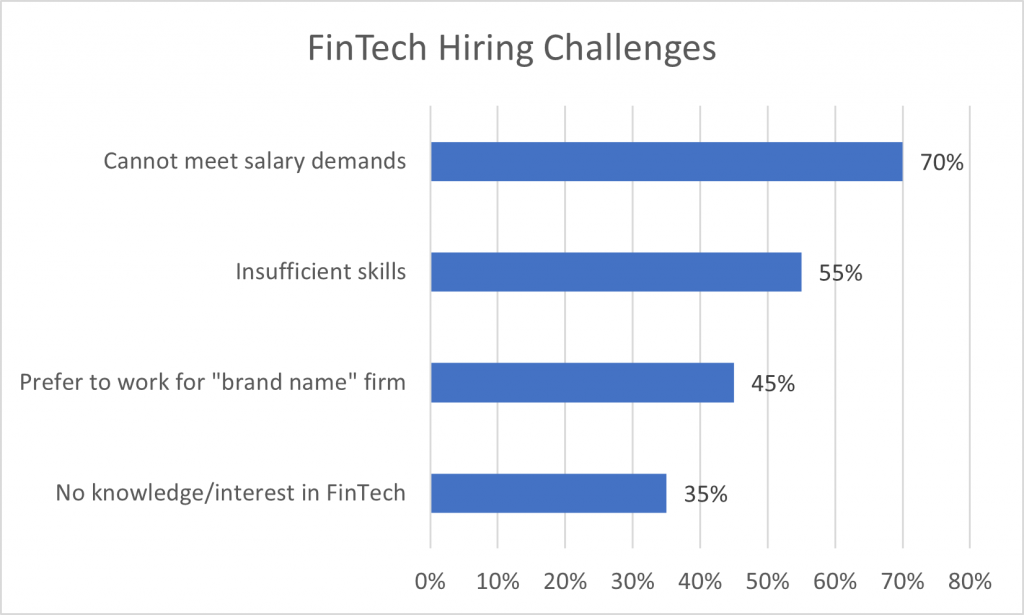Will talent scarcity halt the growth of the Tech Sector?

In this third installment of our series exploring the current level of business insecurity and the impact it has on workforce plans (part one: Will 2021 Be a Year of Thriving or Surviving for Your Workforce?, part two: Has COVID Changed the Definition of “Agile Workforce”?) we focus on an industry that has experienced a positive surge in business as a result of the pandemic – the Tech Sector.
COVID-19 forced people to move from physical to digital interactions for their day-to-day tasks, leading to dramatic growth in online shopping, digital banking, and remote working. Most economists agree that the shift towards a digital economy will become permanent in the post-pandemic world. Technology-focused businesses, of course, benefited from a sudden and dramatic increase in demand. A survey of Tech companies indicated that nearly two-thirds reported zero furloughs in 2020, and more than half reported some form of positive impact from the pandemic.
All is not well in Tech Land, however. Talent is, of course, instrumental to continued growth of the Tech sector. Rapid evolution is required for success, and when the right skills aren’t immediately available growth is stalled. Korn Ferry tells us that by 2030, the United States could be facing a deficit of more than 6 million tech workers, resulting in a loss of $162 billion worth of annual revenues unless it finds more high-tech workers. KPMG surveyed over 3,000 technology leaders for their annual CIO Survey, and found that an astonishing 65% said that hiring challenges are hurting the industry.
The scarcity of tech skills is not new – over the past decade much has been written about the need to increase STEM (science, technology, engineering, mathematics) education. However, COVID-19 has exacerbated an already challenging problem by adding to the list of needed skills. The FinTech (Financial Services Technology) sector exemplifies this problem. This industry is relatively new as every aspect of financial services is being reimagined. The FinTech ecosystem includes solutions for online payment systems, peer-to-peer lending, InsurTech, savings/investments robo-advisors, electronic money transfers/exchange and more.
- As with all Tech Sector companies, FinTech firms include tech specialists, data sciences, project managers, cybersecurity experts, and business analysts are seen as critical hires. But they also require highly specialized resources: Regulatory and compliance officers specializing in anti-money laundering (AML), Know Your Customer (KYC) fraud prevention and regulatory technology (RegTech).
- In some industries, companies have been able to address the talent shortage by hiring entry-level programs and providing incremental training. In the needed FinTech fields, mid-level and senior hires with significant experience, multiple specializations, and a high level of expertise are required.
- There is a global shortage of these resources, and the shift towards remote work has proven to be a double-edged sword. Companies are no longer just working against local competitors, but potentially desirable companies across the world.
- FinTech is a rapidly growing industry with new entrants nearly every day. Pay rates in Fintech remained remarkably resilient in 2020. FinTech firms, particularly startups and scaleups whose resources are tightly limited, struggle to compete.
- Competition for talent is not limited to other Tech Companies. The U.S. government has funded more than 1,000 new cybersecurity positions. And Tech job seekers are uniquely in demand both within the Tech industry and without.
- Even when companies effectively attract and recruit niche tech talent, retention is a major issue. In fact, LinkedIn reports that the tech sector has the highest turnover rate at 13.2% out of every single business sector. The ‘premier’ brands in the Tech sector are not immune from retention issues. Payscale’s recent employee turnover report estimates median tenure at Amazon is just one year, Google has a median tenure of 1.1 years, and Apple just two years.

The Tech industry has built its reputation by embracing innovation. Can innovation in talent sourcing and management be the solution to the talent shortage challenge?
Over the past two decades, nextSource has worked with companies to develop innovate talent sourcing strategies. Simply put, we suggest that Tech Companies fish in a larger pond!
- Consider greater use of contingent workers. Tech workers today are taking advantage of rapidly rising wages by shifting from employment to engagement. Through a series of shorter-term assignments, they receive incremental compensation growth while ensuring challenging assignments that expand their skill sets. This can also work for FinTech firms, engaging talent on an “as needed” basis. It is estimated that it takes 51 days on average to fill vacancies with “permanent employees” in the information technology (IT) industry. Companies are spending billions to not only recruit hard-to-find tech talent but to then replace that same talent when they leave in one to two years. Contingent workers can be secured in shorter time-frames without incurring the effort of sourcing, screening and onboarding those professionals.
- Tap into under-represented talent. In the Tech sector, gender and minority diversity remains low. A recent LinkedIn report indicated that minority tech employees often reported toxic work environments and employee mistreatment. Build a culture of inclusion that works for permanent employees and contingent workers alike.
- Expand your search. Traditionally, Tech companies focused their sourcing efforts on poaching from competitors. Consider candidates who have completed certification programs as well as those with four-year degrees. In addition, the factors which pulled talented individuals to cities designated as Tech hubs may no longer be relevant. The ability to effectively work remotely enables companies to consider offshoring/nearshoring options.
- Tap into the ways candidates find jobs. Nearly 90% of Tech professionals find jobs through personal connections/recommendations. They also follow online job boards (80%). Nearly half have found positions through employment agencies. Less than a quarter of Tech job seekers turn to traditional approaches (campus recruitment, career fairs. Headhunting).
Of course, the “what to do” is often easier than the “how to do it”. nextSource finds that there is no single sourcing approach that will adequately address the talent shortage. Through our Progressive Program Model™ we establish an omnichannel approach to finding talent, and a comprehensive worker nurturing program to maximize retention. The program brings together talent communities, economic development programs, staffing agency sourcing, and engagement of independent contractors and project services team under a single program.
Visit our website to learn more about the tech sector and if you have questions please reach out to us.
Let us know if you’d like to automatically receive insights into the challenges of talent acquisition and management.


